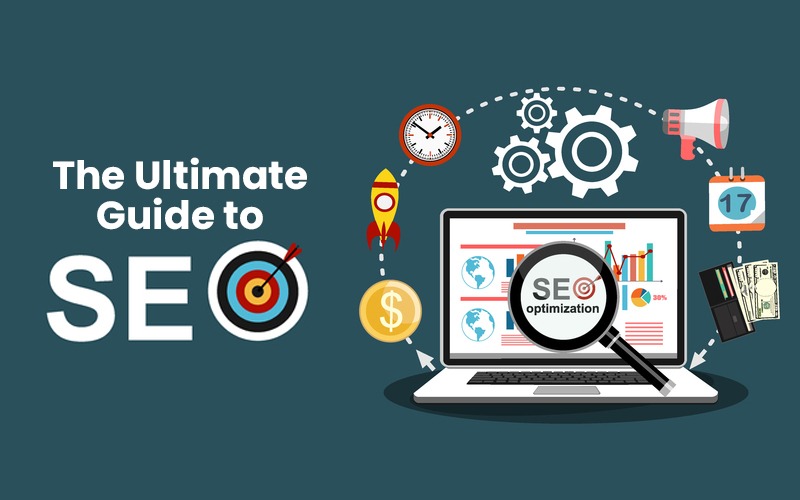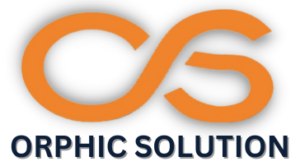Digital Marketing Tips
The Ultimate Guide to SEO: Best Practices for Ranking Higher

Guide to SEO. Introduction: In the ever-evolving landscape of digital marketing, search engine optimization (SEO) remains a crucial component for businesses striving to increase online visibility and drive organic traffic to their websites. With search engine algorithms becoming increasingly sophisticated, mastering SEO best practices is essential for ranking higher in search engine results pages (SERPs). In this comprehensive guide, we’ll explore the fundamentals of SEO and provide actionable strategies to help you optimize your website effectively.
Understanding SEO: Guide to SEO
At its core, SEO is the practice of optimizing your website to improve its visibility in search engine results. Search engines like Google use complex algorithms to determine which websites rank highest for specific search queries. These algorithms take into account various factors, including keywords, content quality, backlinks, user experience, and more Guide to SEO .
Keyword Research: Keyword research forms the foundation of any successful SEO strategy: Guide to SEO
Start by identifying relevant keywords and phrases that your target audience is likely to use when searching for products or services similar to yours. Use keyword research tools such as Google Keyword Planner, SEMrush, or Moz Keyword Explorer to discover high-volume keywords with relatively low competition.
On-Page Optimization: On-page optimization involves optimizing individual web pages to improve their search engine rankings and attract more organic traffic. Key elements of on-page optimization include:

- Title tags: Ensure each page has a unique and descriptive title tag containing relevant keywords.
- Meta descriptions: Write compelling meta descriptions that accurately summarize the content of your page and encourage clicks.
- Heading tags: Use heading tags (H1, H2, H3, etc.) to structure your content and make it more readable for both users and search engines.
- URL structure: Create SEO-friendly URLs that are concise, descriptive, and include target keywords where appropriate.
- Content optimization: Produce high-quality, informative content that satisfies user intent and incorporates relevant keywords naturally.
Technical SEO: Technical SEO focuses on optimizing the technical aspects of your website to improve its crawlability, indexability, and overall performance. Key technical SEO
considerations include:
- Site speed: Improve page load times by optimizing images, minifying CSS and JavaScript files, and leveraging browser caching.
- Mobile-friendliness: Ensure your website is mobile-responsive and provides a seamless user experience across all devices.
- Site architecture: Create a logical site structure with clear navigation and internal linking to help search engines understand the hierarchy of your content.
- Schema markup: Implement schema markup to provide search engines with additional context about your content, such as reviews, ratings, and product information.
Off-Page Optimization: Off-page optimization refers to activities conducted outside of your website to improve its search engine rankings. The most prominent off-page SEO technique is link building, which involves acquiring backlinks from other reputable websites. Focus on earning high-quality backlinks from relevant and authoritative sources within your industry through strategies such as guest blogging, influencer outreach, and content promotion Guide to SEO .
Local SEO: For businesses targeting local customers, optimizing for local search is essential:Guide to SEO
Claim and optimize your Google My Business listing, ensuring that your business name, address, and phone number (NAP) information is accurate and consistent across all online platforms. Encourage satisfied customers to leave positive reviews, as they can significantly impact your local search rankings Guide to SEO .
Monitoring and Analysis : Guide to SEO
Once you’ve implemented your SEO strategy, it’s crucial to monitor its performance and make adjustments as needed. Utilize tools like Google Analytics and Google Search Console to track key metrics such as organic traffic, keyword rankings, and conversion rates. Analyze this data regularly to identify areas for improvement and capitalize on new opportunities.
Conclusion:
Effective SEO is a continuous process that requires ongoing attention and optimization. By following the best practices outlined in this guide, you can enhance your website’s visibility, attract more organic traffic, and ultimately achieve higher rankings in search engine results pages. Remember to stay informed about the latest SEO trends and updates, as search engines are constantly evolving. With dedication and perseverance, you can position your website for long-term success in the competitive world of online search.
Blog
Top 10 Social Media Marketing Tips to Grow Your Brand

Growing your brand on social media can seem challenging, but with the right strategies, it can be a rewarding experience. Here are ten effective social media tips to help you boost brand awareness and engagement.
1. Define Your Goals
The first step in social media marketing strategies is to define your goals. Are you looking to grow your brand on social media, increase engagement, or drive sales? Clear goals will guide your content and strategy.
2. Know Your Audience
Understanding your target audience is crucial. Use social media analytics tools to learn more about your followers’ demographics, interests, and behaviors. This knowledge will help you create content that resonates and boosts brand awareness on social media.
3. Create Engaging Content
Content is king in social media marketing. Focus on creating high-quality, engaging content that adds value to your audience. Use a mix of videos, images, and articles to keep your feed interesting. Effective social media tips include using storytelling to connect with your audience emotionally.
4. Use Hashtags Wisely
Hashtags can significantly increase your reach on platforms like Instagram and Twitter. Research and use relevant hashtags to get your posts seen by a larger audience. Social media growth hacks often include using trending and niche-specific hashtags.
5. Post Consistently
Consistency is key in social media marketing strategies. Create a content calendar to schedule your posts in advance. Regular posting keeps your audience engaged and helps in increasing social media followers.
6. Engage with Your Audience
Interaction is essential for building a loyal community. Respond to comments, messages, and mentions promptly. Social media engagement tips include running polls, Q&A sessions, and live videos to interact directly with your followers.
7. Collaborate with Influencers
Influencer marketing can give your brand a significant boost. Collaborate with influencers who align with your brand values and have a substantial following. This can help in growing your brand on social media and reaching new audiences.
8. Leverage Paid Advertising
Social media advertising tips suggest using paid ads to reach a broader audience. Platforms like Facebook and Instagram offer detailed targeting options to ensure your ads reach the right people. Invest in social media ads to boost brand awareness and drive traffic to your site.
9. Analyze and Adjust
Regularly analyze your social media performance using tools like Google Analytics and native platform insights. Understanding what works and what doesn’t is crucial for refining your social media marketing strategies. Adjust your tactics based on your findings to improve your results.
10. Stay Updated with Trends
Social media is constantly evolving. Stay updated with the latest trends and platform updates to keep your strategy relevant. Follow industry blogs and influencers to get the latest social media growth hacks and effective social media tips.
Conclusion
Implementing these social media best practices will help you grow your brand on social media. Remember, the key is to be consistent, engage with your audience, and continuously refine your strategy based on data and trends. Happy marketing!
By incorporating these strategies, you’ll be well on your way to mastering social media marketing and seeing tangible growth for your brand.
Blog
10 Effective Ways to Use Analytics to Drive Marketing Decisions
In today’s competitive landscape, data-driven marketing is essential for making informed decisions and optimizing campaigns. Utilizing marketing analytics tools can provide valuable insights and help you improve your strategies. Here are ten effective ways to use analytics to drive your marketing decisions.
1. Leverage Customer Insights

Understanding your customers is crucial for crafting targeted marketing campaigns. Analytics tools can provide deep customer insights, such as demographics, behavior patterns, and preferences. By analyzing this data, you can tailor your messages and offers to meet their needs, enhancing engagement and satisfaction.
2. Optimize Conversion Rates
Conversion rate optimization (CRO) is about increasing the percentage of visitors who complete a desired action on your website. Use analytics to identify bottlenecks in your conversion funnel and test different elements to see what works best. Tools like Google Analytics offer insights into user behavior, helping you make data-driven decisions to improve conversions.
3. Utilize Google Analytics Tips
Google Analytics is a powerful tool for tracking and analyzing website traffic. To get the most out of it, follow some essential Google Analytics tips, such as setting up goals, using custom reports, and analyzing user flow. These practices can help you understand how visitors interact with your site and identify areas for improvement.
4. Conduct In-Depth Data Analysis in Marketing
Performing thorough data analysis in marketing allows you to uncover trends, patterns, and insights that can inform your strategy. Use marketing analytics tools to collect and analyze data from various sources, such as social media, email campaigns, and website traffic. This comprehensive approach enables you to make informed decisions based on real data.
5. Track Marketing Performance Metrics
Tracking marketing performance metrics is essential for measuring the success of your campaigns. Key metrics include click-through rates (CTR), conversion rates, and customer acquisition costs. By regularly monitoring these metrics, you can identify what’s working and what needs adjustment, ensuring your campaigns are effective and efficient.
6. Implement Audience Segmentation
Audience segmentation involves dividing your target audience into distinct groups based on specific criteria, such as demographics, behavior, or preferences. Use analytics to identify these segments and tailor your marketing efforts to each group. This approach can lead to more personalized and relevant campaigns, improving engagement and conversion rates.
7. Focus on ROI Tracking
Return on investment (ROI) tracking is critical for understanding the financial impact of your marketing efforts. Use analytics tools to measure the ROI of different campaigns and channels. This information helps you allocate resources more effectively and focus on strategies that deliver the highest returns.
8. Utilize Predictive Analytics in Marketing
Predictive analytics in marketing involves using historical data and machine learning algorithms to forecast future trends and behaviors. This approach can help you anticipate customer needs, optimize inventory, and plan marketing campaigns more effectively. By leveraging predictive analytics, you can stay ahead of the competition and make proactive decisions.
9. Enhance Marketing Campaigns with A/B Testing
A/B testing is a method of comparing two versions of a marketing asset to see which one performs better. Use analytics to track the performance of different elements, such as headlines, images, or call-to-action buttons. This data-driven approach allows you to make informed decisions about what works best for your audience.
10. Integrate Data from Multiple Sources
To get a complete picture of your marketing performance, integrate data from various sources, such as social media, email marketing, and web analytics. Marketing analytics tools can help you consolidate this data and provide a holistic view of your campaigns. This comprehensive approach enables you to make more informed decisions and optimize your overall strategy.
By implementing these ten effective ways to use analytics, you can drive better marketing decisions, optimize your campaigns, and achieve greater success. Embrace data-driven marketing and leverage the power of marketing analytics tools to stay ahead in the competitive landscape.
Blog
10 Tips and Tricks for Effective PPC Campaigns
In today’s competitive digital landscape, mastering pay-per-click (PPC) advertising is essential for driving targeted traffic and achieving business goals. Here are 10 tips and tricks to ensure your PPC campaigns are effective and yield maximum returns.
1. Conduct Thorough PPC Keyword Research

Keyword research is the cornerstone of any successful PPC campaign. Utilize tools like Google Keyword Planner to find relevant keywords for your niche. Focus on both short-tail and long-tail keywords to capture a broader audience. Regularly update your keyword list to stay aligned with current trends in PPC keyword research and pay-per-click advertising.
2. Optimize Your Ad Copy
Creating compelling ad copy is crucial for attracting clicks. Highlight the unique selling points of your product or service and include a clear call-to-action (CTA). Make sure your ad copy is relevant to the keywords you’re targeting in your PPC campaigns. Test different variations to see which performs best in ad copy optimization.
3. Utilize Negative Keywords
Negative keywords prevent your ads from showing up for irrelevant searches, saving you money and improving your campaign’s effectiveness. Regularly review your search terms report in Google Ads tips to identify and add negative keywords. This is a crucial part of PPC optimization and PPC management.
4. Focus on Quality Score
Effective PPC campaigns rely heavily on Quality Score to determine ad rankings and costs. Improve your Quality Score by ensuring your ads are relevant to your keywords, optimizing your landing pages for user experience, and maintaining a high click-through rate (CTR). This is one of the best PPC tips and tricks.
5. Segment Your Campaigns
Segmenting your PPC campaigns allows for more targeted advertising. Create separate campaigns for different product lines, geographic locations, or audience segments. This strategy enables you to tailor your ad copy and keywords more precisely, leading to better performance and PPC campaign success.
6. Optimize Landing Pages
Ensure that your landing pages are relevant to the ads and keywords used in your PPC strategies. A well-optimized landing page should load quickly, be mobile-friendly, and have a clear CTA. The goal is to provide a seamless user experience that encourages conversions and aids in PPC optimization.
7. Use Ad Extensions
Ad extensions enhance the visibility and effectiveness of your ads by providing additional information. Utilize site link extensions, callout extensions, and structured snippets to give potential customers more reasons to click on your ads. These features can significantly improve the performance of your Google PPC campaigns and are a vital part of PPC best practices.
8. Monitor and Adjust Bids
Effective bid management is crucial for maximizing the ROI of your pay-per-click advertising. Use automated bidding strategies offered by Google PPC, but also monitor and adjust bids manually based on performance data. Increase bids for high-performing keywords and reduce them for those that aren’t delivering results. This is essential for PPC budget management.
9. Track Conversions
Set up conversion tracking to measure the success of your PPC strategies. Use tools like Google Analytics to track actions such as form submissions, product purchases, and sign-ups. Analyzing this data helps you understand what’s working and what needs improvement in your paid search advertising efforts. Effective PPC performance tracking is key.
10. Regularly Review and Optimize
PPC campaigns require ongoing maintenance to stay effective. Regularly review performance metrics and optimize your campaigns based on the data. Make adjustments to keywords, ad copy, bids, and targeting as needed to ensure continuous improvement and sustained success in your pay-per-click advertising.
By implementing these PPC tips and tricks, you can enhance the effectiveness of your PPC campaigns, drive more targeted traffic, and achieve your business objectives. Remember, successful PPC strategies are all about continuous learning and adaptation. Stay updated with the latest Google Ads tips and best practices in PPC management and paid search advertising to keep your campaigns performing at their best.
FAQs
1. What is the importance of PPC keyword research in PPC campaigns?
PPC keyword research is essential for identifying the most relevant and high-performing keywords for your ads. It helps in targeting the right audience, improving ad relevance, and ultimately driving more effective PPC results.
2. How can I optimize ad copy for my pay-per-click advertising?
To optimize ad copy, focus on creating compelling and relevant content that highlights your unique selling points. Include a clear call-to-action (CTA), and use A/B testing to determine which variations perform best. This is crucial for effective ad copy optimization.
3. Why are negative keywords important in Google PPC campaigns?
Negative keywords prevent your ads from appearing for irrelevant searches, saving your budget and increasing the efficiency of your PPC campaigns. Regularly updating your negative keywords list is a key part of PPC optimization.
4. How does Quality Score impact my Google Pay-Per-Click campaigns?
Quality Score affects your ad rankings and cost-per-click (CPC). Higher Quality Scores can lead to better ad positions and lower costs. Improving ad relevance, optimizing landing pages, and maintaining a high click-through rate (CTR) are vital for a good Quality Score.
5. What are some best practices for segmenting PPC campaigns?
Segment your PPC campaigns by product lines, geographic locations, or audience segments. This allows for more precise targeting and tailoring of ad copy and keywords, leading to better performance and PPC campaign success.
6. How can I optimize landing pages for better PPC results?
Ensure your landing pages are relevant to the ads and keywords used. They should load quickly, be mobile-friendly, and have a clear CTA. A well-optimized landing page improves user experience and conversion rates, essential for PPC optimization.
7. What are ad extensions, and how do they benefit my PPC campaigns?
Ad extensions provide additional information about your business, such as site links, callout extensions, and structured snippets. They enhance ad visibility and effectiveness, improving the performance of your Google PPC campaigns.
8. How should I manage bids for my PPC strategies?
Effective bid management involves using automated bidding strategies and manually adjusting bids based on performance data. Increase bids for high-performing keywords and reduce them for underperforming ones. This is crucial for PPC budget management.
9. Why is conversion tracking important in pay-per-click advertising?
Conversion tracking helps measure the success of your PPC strategies by tracking actions like form submissions, purchases, and sign-ups. It provides insights into what’s working and what needs improvement, essential for effective PPC performance tracking.
10. How often should I review and optimize my PPC campaigns?
PPC campaigns require regular review and optimization to stay effective. Continuously monitor performance metrics and make adjustments to keywords, ad copy, bids, and targeting to ensure ongoing improvement and PPC campaign success.







